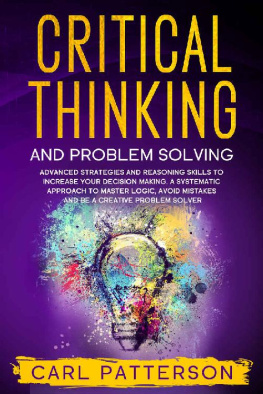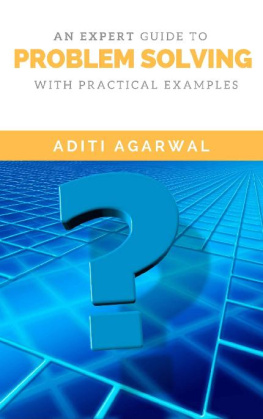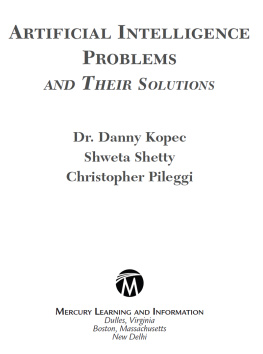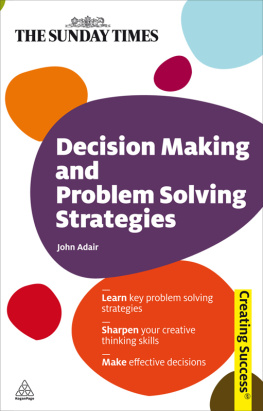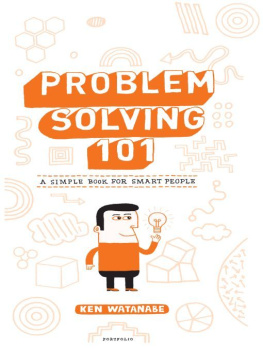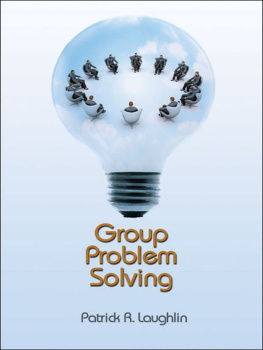Stanford University Press
Stanford, California
2015 by McKinsey & Company, Inc., and Mihnea C. Moldoveanu.
All rights reserved.
No part of this book may be reproduced or transmitted in any form or by any means, electronic or mechanical, including photocopying and recording, or in any information storage or retrieval system without the prior written permission of Stanford University Press.
Printed in the United States of America on acid-free, archival-quality paper
Library of Congress Cataloging-in-Publication Data
Moldoveanu, Mihnea C., author.
The design of insight : how to solve any business problem / Mihnea C. Moldoveanu and Olivier Leclerc.
pages cm
Includes bibliographical references.
ISBN 978-0-8047-9409-1 (pbk. : alk. paper)
1. Problem solving. 2. Insight. 3. Industrial management. I. Leclerc, Olivier, (Business consultant), author. II. Title.
HD30.29.M58 2015
658.4'03dc23
2015004647
ISBN 978-0-8047-9579-1 (electronic)
Typeset by Bruce Lundquist in 10/13 Adobe Garamond
THE DESIGN OF INSIGHT
How to Solve Any Business Problem
MIHNEA C. MOLDOVEANU AND OLIVIER LECLERC
stanford briefs
An Imprint of Stanford University Press
Stanford, California
CONTENTS
PREFACE
This is not merely a book but a platform for defining, structuring, and solving business problems. Business problems are not like math problems, economics problems, or engineering problems: they are more like quandaries, issues, predicaments, and situations that must be defined before they are solved. To be defined, they must be articulated, and the basic disciplines of business and management to date have tried to sweep the difficulty of defining problems under the rugs of their own language systems. What we do here is lay bare this black box of business problem definition and break it down so that it can be mastered and practiced in any business domain. To do so, we introduce a set of powerful, universal modeling languages that will allow you to represent any issue, predicament, or difficulty in any one of five problem-solving languages: languages that will let you build models of the predicament that will give you a well defined problem to solve. We call these languages flexons (flexible objects for the generation of novel solutions).
Model-based problem solvingthe discipline our platform teaches and gives you practice withis useful not only because it allows you to generate precise, deep, and accurate problem statements in any domain of business practice, but also because it allows you to design your problem-solving process for insight. Having five modeling languages is more than five times more valuable than having one, because business problems are unlikely to yield to insights generated from any one language alone and far more likely to yield to an adaptive tool kit of languages. We will show you both why and how.
Like any other discipline, practice is paramount, so our platform is relentlessly practice oriented. Each modeling tool kit comes with a set of training examples that are drawn from actual business scenarios and predicaments and are either current or have occurred very recently. By the end of the training sequence, you will have seen, defined, and solved problems ranging from smart phone design to currency trading, from executive team mismanagement to vertical integration in the auto industry, and from pharmaceuticals research and development process improvement to private equity deal flow optimization.
We offer our deep and sincere thanks to Margo Beth Fleming, our editor, who insightfully guided our efforts throughout; Raluca Cojocariu for her tireless editorial assistance and support; Alex Yeo who provided helpful comments and suggestions on several drafts of the book; and Graham Huber, who helped define and design a graphical language that makes flexons more intuitive and vivid than any of us could have made them.
WHAT IS THIS ALL ABOUT?
Innovative solutions to complex business problems are like works of art: they elicit emotions similar to the ones we feel in front of great paintings or photographs. They transform our views of the world by showing it to us from different perspectives. When Yann Arthus-Bertrand shows us a photograph of the earth from the sky, it not only expands our horizons in the literal sense but reveals unsuspected patterns in the landscapes we thought we knew well.
A new theory, like the special theory of relativity, does even more for us. Einsteins insight that light moves at the same speed in any inertial frame implies that space, time, and the mass of a moving object contract or expand as a function of the speed with which the object moves relative to a nonaccelerating frame. It is a lens that lets us make a new and valid prediction: the rate at which particles energy states will decay as a function of the speed with which they move, something the previous picture of space-time did not predict. The new theory does not give us new information. It adds new insight to existing informationto the facts we knew when looking through the old lensand sets our gaze on critical new information we can seek out.
A new way of looking at a business can also make unseen patterns visible and reveal innovative levers we can use to drive changes that have impact. When Coca Cola describes itself as a conditioned reflex business rather than a soft drinks business, its marketing department begins to think about how to engineer stimuli that will trigger customers buy-and-consume routine so reliably that it becomes a reflex. Then the company sets to work on optimizing the color of the drink, the shape of the container, and the sound patterns of the commercials to trigger consumers desire to have a Coke and a smile as a matter of reflex rather than a considered choice.
Google understands itself as a company constantly searching for the best search process. Its approach to research, development, and deployment has taken on a vinelike characteristicone that is adaptive and expanding. Search, writ large, is its raison dtre, which encourages it to stay at the forefront of a human activitysearch and re-searchthat has been addictive since before we knew what the Internet was. Google Earth, Google Books, Google Scholar, Google Patents, and Google Code are all exploration vehicles that expand users search repertoire while furthering the companys own search for better ways to search.
The business world offers up challenges involving large sets of variables on consumer behavior, trends, regulatory uncertainties, shifting competition, new technologies, and more. Finding a way to see these variables in ways that illuminate an insightful course of action is not so different from seeing the world through Bertrands photo lens or seeing time and space through Einsteins model. The trick is to discover a lens that focuses us on the variables that matterthose we can observe and control to bring about useful change. To do so, we need to look and see differently. We get to insight by building and using a new lens, not just by collecting more data and analyzing it. That is how we design insight.
Shedding new light on a predicament is hard because we tend to gravitate toward familiar ways of seeing. Our existing models, metaphors, and frames shape our ways of looking, and precedents constrain what we end up looking for. They can provide useful shortcuts for transferring insight from one field of practice to another, but they are our enemies in producing new insight: they are the pictures we took using yesterdays lenses.
This book is an exercise regime for the business mind that seeks insighta personal problem-framing and problem-solving assistant for business problem solvers. It can be used as a think-out-loud document for strategists, advisors, and executives, alone or in teams, and it answers the questions that should guide all insight seekersfor example:
Next page

